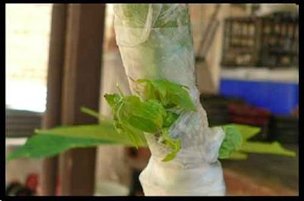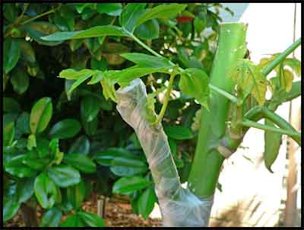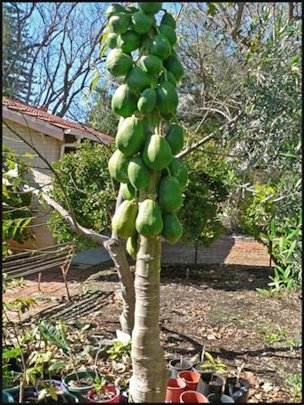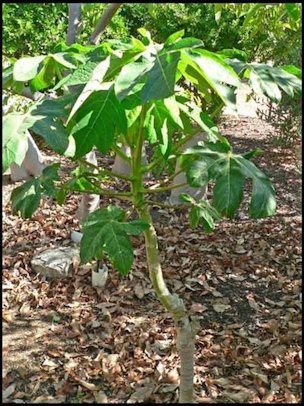
Grafting Pawpaws
Isolated
published
scientific studies report it's possible although difficult to graft
pawpaws. But you probably won't see any mention of this propagation
technique in your usual reference sources because of several important
characteristics of the species.
| • |
Almost
exclusively, growers from backyarders to big commercial
operations worldwide use seed propagation because each fruit produces
hundreds of viable seeds that store well, germinate easily and can
produce fruit in less than a year with ideal climatic conditions and
optimal management. |
| • |
It
is one of the very few
major fruit tree crops in the world propagated in this way, as usually
there's a more prolonged juvenile period over some years with
seedlings, and vegetative propagation usually halves this
non-productive period. |
| • |
The superior fruiting
qualities of selected cultivars, normally desired in other fruits which
require vegetative or micro-propagation techniques to be maintained,
are less important in pawpaws. The hermaphrodites favoured in tropical
climates can become almost pure breeding lines after several
generations of controlled in-breeding as they primarily self-pollinate.
In sub-tropical climates like ours, the dioecious varieties perform
better, and although subject to normal sexual variation can be
manageable with selection of seed from superior trees and by
restricting open pollination from unknown males or hermaphrodites. At
least half the gene pool in this situation (the female side) has been
selected. |
| • |
Pawpaws have very strong apical
dominance which results in them normally being single-trunked, with
axial fruiting occurring as meristematic buds located in the tip region
differentiate into flowers. As an herbaceous, soft-wooded and
hollow-stemmed species, this region is very delicate and not hardened
to minimise desiccation as in other more woody species. Lateral buds
lower down the stem remain inhibited under normal conditions, but can
develop slowly following injury or pruning of the apical region. This
means scion material for grafting is typically non-ideal, either too
delicate from the tip and requiring fastidious control of humidity, or
strongly inhibited if lower segments are used.
|
| • |
Normal grafting (eg whip or
cleft) requires matching of the cambial
regions of scion and rootstocks, but unless relatively mature males are
used for the rootstock there'll be a gross mismatch in diameters
between them. |
| • |
The species is lactiferous,
which interferes with timely union of cambial regions from scion and
rootstock. |
A
principal problem that all growers face with seedling propagation is
that it's not possible to determine sex in the field before flowering.
As a consequence the common practice is to put 3-4 seedlings in the one
planting hole, wait till flowering then cull those males or
non-vigorous females not needed. With dioecious varieties only one male
is needed to pollinate several females and this means considerable time
and resources have been wasted raising these superfluous plants. For
the home grower who is only interested in a small number of plants,
Murphy's Law inevitably kicks in and the several potted plants you've
grown up ready for in-ground planting could be almost all males. Like
everyone else I've been propagating my plants by seeds and I replace my
chosen 3-4 mature females every few years to keep up yield and quality,
so I always have new plants coming through. In the past I've just
killed the unwanted excess males and hoped the females would give good
quality fruit, but it's still a bit hit and miss.

Date of photo: January 14 2016
This
year for the first time I decided to have a go at a graft - the
unwanted male would have been sacrificed anyway and if it didn't take
there'd be nothing lost. One of my females was in the last year of
production and I'd topped it to reduce height. The expected lower
branching slowly developed, providing smaller diameter scion material
in vegetative growth mode. Then, a decision had to be made on which way
to go, the tip region or lower down the branch? I decided to go with
the latter and hoped I could get the graft to take with sufficient
lateral bud growth before it all dried out. This meant it was far
easier to match diameters of scion and rootstock for a cleft graft as
the small male seedling had just started to produce flowers. So far it
looks like it's going to work, as shown in the picture. If so, I'm
assured of getting fruit the equivalent of my best quality tree and it
could become the main way I generate stock for each renewal cycle.
There's a further favourable possibility – males are usually more
vigorous than females so a grafted plant on male rootstock could also
be more vigorous, giving greater yield. A tip if you decide to have a
go – the very soft stem material provides little mechanical strength to
hold the scion firmly, so bind tightly with grafting tape and keep the
scion relatively short so it won't be too top heavy.
Update
Literature
reports indicate cleft grafting can be successful with pawpaws, and
consequently this was the first technique I tried. However the very
soft-wooded lateral branches that are the most likely source of
suitably responsive dormant buds mean that without external support,
the slowly desiccating scion can wilt and become difficult to maintain
in firm and fixed cambial contact with the rootstock in the period
before the union becomes functional. I thought a side graft could
effectively address this limitation as the remaining root stock above
the graft area would provide a ready-made stabilising ‘post’ for
anchoring the scion. A further consideration was that root stock leaves
left above the graft would ensure continuation of sap flow around the
graft region and enhance the chances of take. Result - within two weeks
I had new growth in the scion, and this rapidly went on to the level
shown in the picture. It seems to be a better way to go than top
working with a cleft graft.

Successful papaya side graft
Pawpaw side graft update 2
This
picture taken several months later shows the plant growing on nicely
after not doing very much over an unusually long, cold winter and
spring this year. Already forming flower buds and hopefully good fruit
will come through in the not-too-distant future, given the female scion
pedigree.
Date of photo: 23rd December 2016
Pawpaw side graft update 3
Fruit
set in autumn, stalled through winter and is now maturing nicely. This
illustrates such vegetative propagation gives fairly rapid fruit
production of selected phenotype. Graft region can be seen at about
knee height.

Date of photo: 10th October 2017
Back to
Papaya Page
|




